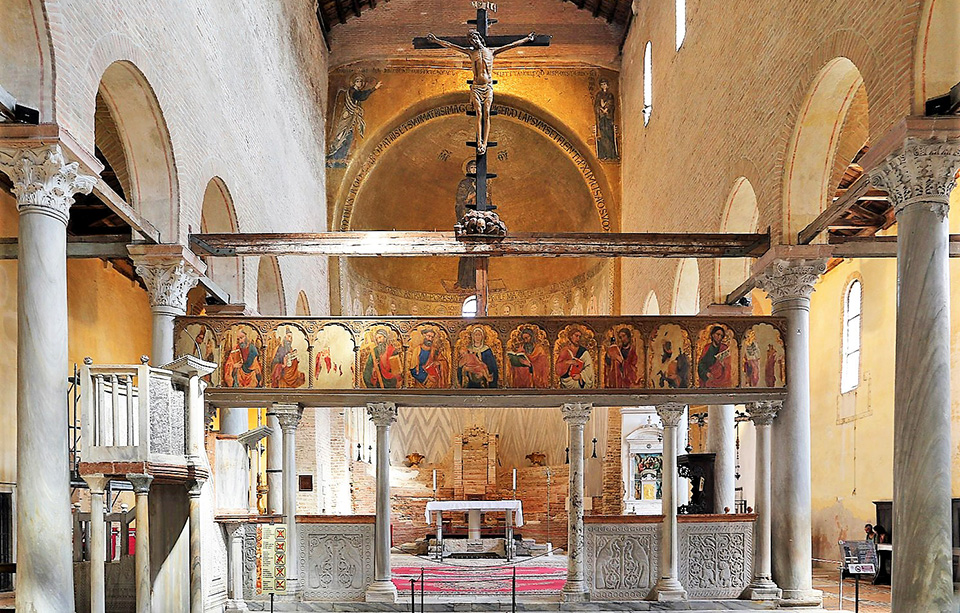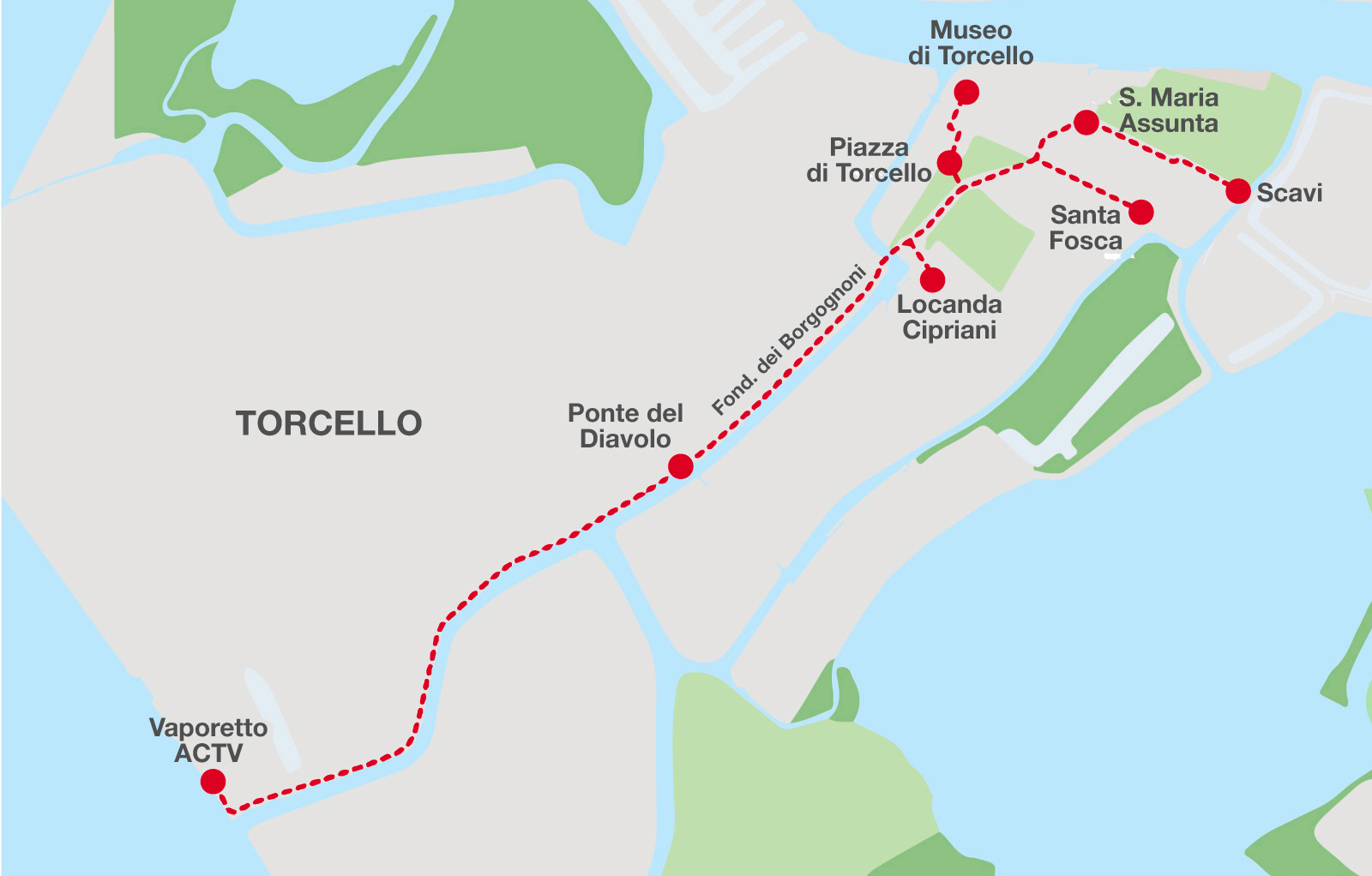The Torcello Island is a quiet and sparsely populated island at the northern end of the Venetian Lagoon. It is considered the oldest continuously populated region of Venice. Today it has 12 inhabitants.
Torcello Island is worth a visit: A magnificent Byzantine-Italian cathedral dating back to 639 A.D., the Basilica of Santa Maria Assunta, looms over the island with the Bell Tower and Church of Santa Fosca alongside. Allow 45 minutes or an hour to visit the religious buildings around the central piazza, which is a short walk along a canal from the Actv stop.
Sights of Torcello island
The former splendour of Torcello’s numerous palazzi, its twelve parishes and its sixteen cloisters has almost disappeared since the Venetians recycled the useful building material. The only remaining medieval buildings form an ensemble of four edifices.
Today's main attraction is the Cathedral of Santa Maria Assunta, founded in 639 and with much eleventh and 12th century Byzantine work, including mosaics (e.g. a vivid version of the Last Judgement), surviving. Other attractions include 12th century Church of Santa Fosca, which is surrounded by a porticus in form of a Greek cross, and a Archaeological Museum housed in two fourteenth century palaces, the Palazzo dell'Archivio and the Palazzo del Consiglio, which was once the seat of the communal government. Another noteworthy sight for tourists is an ancient stone chair, known as Attila’s Throne. It has, however, nothing to do with the king of the Huns, but it was most likely the podestà’s or the bishop’s chair.
Don't miss the Torcello Bell Tower, which offers a 360° view of the lagoon and is therefore worth climbing to the top. Torcello is also home to a Devil's Bridge, known as the Ponte del Diavolo or alternatively the Pontecello del Diavolo (devil's little bridge).
How to get Torcello from Venice
In Venice, head to the Fondamente Nove pier, north of Venice. From there, take the ACTV vaporetto – Line 12 to Burano and there change to the vaporetto Line 9 to Torcello. The trip takes approximately 1 hour and includes a short stop on the island of Burano, which is just 5 minutes from Torcello. Or book a private boat trip to the islands of Murano, Burano and Torcello:
Opening Hours in Torcello Island
- Torcello Basilica: Every day from 10.30 to 17.00 (last admission 16.30)
- Torcello Bell Tower: Every day from 10.30 to 16.30 (last admission 16.00)
- Torcello Museum:
- From March 1st to October 31st: Tuesday to Sunday 10.30 – 17.30 (last admission 17)
- From November 1st to February 28th: Tuesday to Sunday 10.00 – 17.00 (last admission 16.30)
Torcello Basilica, Bell Tower, Museum and Audiotour Tickets
Tickets are sold individually for the Basilica, the Bell Tower, and the small Archaeological Museum, but the best deal is a combination ticket that includes all three plus the use of an audioguide in the Basilica (still called the "Cathedral" by many, and still in use for weddings and religious festivals).
Entrance Tickets (2025):
- Basilica - 5 euro.
- Bell Tower - 5 euro.
- Basilica + Bell Tower + Archaeological Museum of the Province of Venice with audio guide
- Full: 9.00 euro
- Reduced: 6.00 euro (minimum groups of 10 people)
- Free: children under 6 years.
Where to eat on Torcello Island?
- Ristorante Al Trono di Attila: Fondamenta Borgognoni, 7/a Torcello.
- Osteria Al Ponte del Diavolo: Fondamenta dei Borgognoni, 10/11 Torcello.
- Ristorante Villa '600: Fondamenta Borgognoni, 12 Torcello.
- Locanda Cipriani: Piazza S. Fosca, 29 Torcello.
Famous residents in Torcello
One of the most famous fans of the island’s decayed and contemplative charm was the writer Ernest Hemingway who spent some time there in 1948, writing parts of Across the River and Into the Trees in Locanda Cipriani.
It is also prominently featured in Harold Pinter's play Betrayal, based on events in an affair he had in the 1960s with Joan Bakewell, the pivotal event of which occurred when she was vacationing in Venice.
Torcello Map
Torcello History
After the downfall of the Roman Empire, Torcello was one of the first lagoon islands to be successively populated by those Veneti who fled the terra firma (mainland) to take shelter from the recurring barbarian invasions, especially after Attila the Hun had destroyed the city of Altinum and all of the surrounding settlements in 452. Although the hard-fought Veneto region formally belonged to the Byzantine Exarchate of Ravenna since the end of the Gothic War, it remained unsafe on account of frequent Germanic invasions and wars. During the following 200 years the Langobards and the Franks fuelled a permanent influx of refugees to the island’s relative safety, including the Bishop of Altino himself. In 638 Torcello became the bishop’s official see for more than a thousand years and the people of Altinum brought with them the relics of Saint Heliodorus, now the patron saint of the island.
Torcello benefited from and maintaining close cultural and trading ties with Constantinople, after the fall of the western Roman Empire, but as a rather distant outpost of the Byzantine Empire it could establish de facto autonomy from the eastern capital.
Torcello rapidly grew in importance as a political and trading centre: In the 10th century it had a population of at least 10,000 people and was much more powerful than Venice. Thanks to the lagoon’s salt marshes, the salines became Torcello’s economic backbone and its harbour developed quickly into an important re-export market in the profitable east-west-trade, which was largely controlled by Byzantium during that period. Fortunately for the island of rivus altus (Rialto), the lagoon around the island of Torcello gradually became a swamp from the 12th century onwards and Torcello’s heyday came to an end. Navigation in the laguna morta (dead lagoon) was impossible before long and the growing swamps seriously aggravated the malaria situation, so that the population abandoned the worthless island bit by bit and left for Murano, Burano or Venice. It now has a population of around 12 people.
There is no agreement on the origin of the name Torcello. Some say it is the name of a tower in the Roman city of Altino, where the first settlers came from; others say it is because its bell tower rises to the sky, and others say it comes from the word torchio, meaning grape press, because of the vines that were grown on the island.
Milestones in the history of Torcello
- 1st-2nd century AD - The island was inhabited in Roman times. Its inhabitants were dedicated to hunting, fishing and salt gathering.
- 452 AD - The invasion of Attila's Huns forced the inhabitants of the city of Altino to abandon the mainland. A gradual transfer of its inhabitants took place until the conditions on the island of Torcello were right for the transfer to be complete.
- 476 AD - Fall of the Roman Empire.
- 639 AD - Altino falls into the hands of the Longobards, a Germanic people who invade Byzantine Italy in 568. In 774 they are displaced by the Franks. The inhabitants of Altino take refuge en masse in Torcello, taking their relics with them. The diocese is transferred and Torcello becomes the episcopal seat. The population of Torcello becomes very large. The first cathedral is built at this time. The small islands around Torcello are also populated, whose place names derive from the ancient gates of Altino: Mazzorbo, Burano, Murano, Ammiana, etc.
- 12th and 13th centuries - Torcello enjoys a flourishing trade based on the manufacture of wool. Venice would grant it the exclusive rights to this trade in 1272.
- 14th century - Torcello reaches 30,000 inhabitants. The island is at its peak.
- 15th century - Torcello's decline begins, the island becomes unrecognisable. The unhealthy environment and the proximity and splendour of Venice lead to the island being abandoned. In the 15th century, the Venetians diverted the last rivers that flowed into the Lagoon because of the danger of burying this body of water. They diverted the river Sile, which flowed in front of Torcello and which had progressively turned the surroundings of the island into a swamp, causing the place to become unhealthy. Things got worse because of successive epidemics of plague and malaria. The island was depopulated in favour of Murano and Venice. The community disappeared. The diocese moved to Murano. With the decline of Torcello, the buildings were dismantled by its inhabitants who used these materials to build their new buildings in Venice. The monasteries of San Tommaso dei Borgognoni, Sant'Antonio or San Giovanni Evangelista disappear.




